 W
WHunting is the practice of seeking, pursuing and capturing or killing wild animals. Hunting wildlife or feral animals is most commonly done by humans for meat, recreation, to remove predators that can be dangerous to humans or domestic animals, to remove pests that destroy crops or kill livestock, or for trade. Many non-human species also hunt.
 W
WAnimal trapping, or simply trapping, is the use of a device to remotely catch an animal. Animals may be trapped for a variety of purposes, including food, the fur trade, hunting, pest control, and wildlife management.
 W
WThe "Bambi effect" is an objection against the killing of animals that are perceived as "cute" or "adorable", such as deer, while there may be little or no objection to the suffering of animals that are perceived as somehow repulsive or less than desirable, such as pigs or other woodland creatures.
 W
WBeelining is an ancient art used to locate feral bee colonies. It is performed by capturing and marking foraging worker bees, then releasing them from various points to establish the direction and distance of the colony's home. Beeliners generally have homemade capture boxes which aid them in their quest.
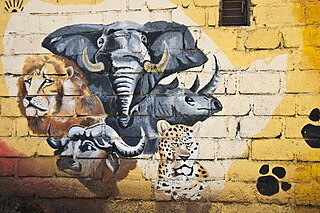 W
WIn Africa, the Big Five game animals are the lion, leopard, rhinoceros, elephant, and Cape buffalo. The term was coined by big-game hunters, and refers to the five most difficult animals in Africa to hunt on foot, but is now also widely used by safari tour operators.
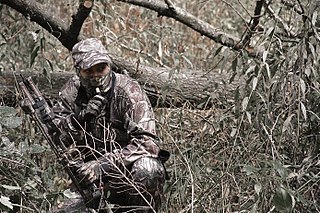 W
WBowhunting is the practice of hunting game animals by archery. Many indigenous peoples have employed the technique as their primary hunting method for thousands of years, and it has survived into contemporary use for sport and hunting.
 W
WCamouflage is the use of any combination of materials, coloration, or illumination for concealment, either by making animals or objects hard to see, or by disguising them as something else. Examples include the leopard's spotted coat, the battledress of a modern soldier, and the leaf-mimic katydid's wings. A third approach, motion dazzle, confuses the observer with a conspicuous pattern, making the object visible but momentarily harder to locate. The majority of camouflage methods aim for crypsis, often through a general resemblance to the background, high contrast disruptive coloration, eliminating shadow, and countershading. In the open ocean, where there is no background, the principal methods of camouflage are transparency, silvering, and countershading, while the ability to produce light is among other things used for counter-illumination on the undersides of cephalopods such as squid. Some animals, such as chameleons and octopuses, are capable of actively changing their skin pattern and colours, whether for camouflage or for signalling. It is possible that some plants use camouflage to evade being eaten by herbivores.
 W
WA catch dog is a specially trained dog that is used to catch large animals in hunting, working livestock, and baiting.
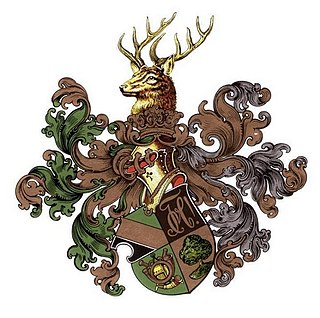 W
WThe Corps Hubertia Freiburg is a fraternity (Studentenverbindung) in Freiburg, Germany. It was founded on October 29, 1868 and is one of 162 German Student Corps in Europe today. The Corps is a member of the Kösener Senioren-Convents-Verband (KSCV), the oldest federation of classical European fraternities with roots dating back to the 15th century and member fraternities across Austria, Belgium, Germany, Hungary, Latvia and Switzerland.
 W
WDolphin drive hunting, also called dolphin drive fishing, is a method of hunting dolphins and occasionally other small cetaceans by driving them together with boats and then usually into a bay or onto a beach. Their escape is prevented by closing off the route to the open sea or ocean with boats and nets. Dolphins are hunted this way in several places around the world, including the Solomon Islands, the Faroe Islands, Peru, and Japan, the most well-known practitioner of this method. By numbers, dolphins are mostly hunted for their meat; some end up in dolphinariums.
 W
WDrag hunting, or draghunting, is a form of equestrian sport, where mounted riders hunt the trail of an artificially laid scent with hounds.
 W
WThere are at least two hundred and twelve detailed drawings by Douglas Hamilton of South Indian landscapes, game animals and forestry operations. Eighty seven of Hamilton's careful drawings of the Annaimalai Hills, Palani Hills and Shevaroy Hills are in the British Library, ninety six drawings were published in his autobiography, Records of Sport in Southern India... and an additional thirty one were published in Forests and Gardens of South India.
 W
WA duck call may be either the sound-imitation process by which a hunter lures waterfowl, or the actual tool which the person uses to do so. Early duck call tools were basic woodwind instruments, while later innovations are constructed of rubber and plastic, and allow the hunter to adjust the volume and tone of the calls with reeds. Today's duck calls usually fall into three main categories: a single, double, or triple reed call with many variations, although the triple reed is rare. The goal of a duck call is to sound like a realistic live duck, in attempts to decoy, or fool a duck into believing the decoys that are seen by a duck, and the sound that is heard appears lifelike.
 W
WField dressing is the process of removing the internal organs of hunted game, and is a necessary step in preserving meat from animals harvested in the wild. Field dressing must be done as soon as possible in order to ensure rapid body heat loss, and prevent bacteria from growing on the surface of the carcass. Field dressing helps maintain the overall quality of the meat. It also makes it considerably easier for a hunter to carry larger game from the hunt area.
 W
WA field hunter, or a fox hunter, is a type of horse used in the hunt field for fox hunting and stag hunting.
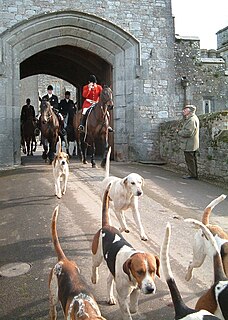 W
WField sports are outdoor sports, especially hunting, shooting, and fishing.
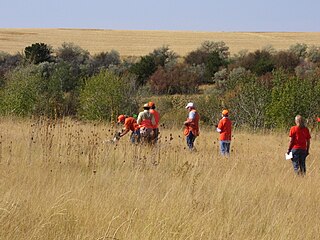 W
WA field trial is a competitive event at which dogs compete against one another for placements. There are field trials for retrievers, pointing dogs and flushing dogs. Field trials are usually organized by kennel clubs or other gun dog organizations. Field trials are generally considered more competitive than hunt tests in that success at a field trial requires a higher level of training than simply qualifying to the standard that a hunt test requires. For example, in Retriever Field Trials, dogs retrieve over longer distances with a more complex path than a Retriever Hunt Test would generally provide. Field trial dogs are trained to a much higher degree of training in order to be competitive in the sport. Their purpose is also different, as they compete for 1st-4th, Reserve Judges' Award of Merit and Judges' Award of Merit, while hunting tests are judged on whether the standard is met or not.
 W
WGame or quarry is any animal hunted for food, and the meat of those animals. The type and range of animals hunted for food varies in different parts of the world.
 W
WThe game drive system is a hunting strategy in which game are herded into confined or dangerous places where they can be more easily killed. It can also be used for animal capture as well as for hunting, such as for capturing mustangs. The use of the strategy dates back into prehistory. Once a site is identified or manipulated to be used as a game drive site, it may be repeatedly used over many years.
 W
WA game farm is a place where game animals are raised to stock wildlife areas for hunting. The term also includes places where such animals are raised to be sold as food or for photography. Their existence has been exemplified within the South African countryside where they have become prevalent. The wildlife that is hunted is used for consumption as well for ecotourism. Local laws in South Africa during the 20th century have allowed the private ownership of wildlife, which has enabled the expansion and economic feasibility of game farms over typical livestock farming.
 W
WA game larder, also sometimes known as a deer or venison larder, deer, venison or game house, game pantry or game store, is a small domestic outbuilding where the carcasses of game, including deer, game birds, hares and rabbits, are hung to mature in a cool environment. A feature of large country houses in Britain and parts of northern Europe from the 18th century, game larders continue to be used by shooting estates.
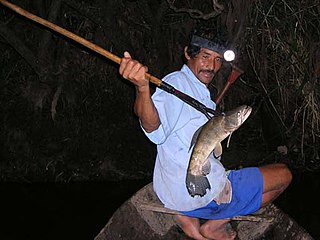 W
WGigging is the practice of hunting fish or small game with a gig or similar multi-pronged spear. Commonly harvested wildlife include freshwater suckers, saltwater flounder, and small game, such as frogs. A gig can refer to any long pole which has been tipped with a multi-pronged spear. The gig pole ranges in length from 8 to 14 feet for fish gigs and 5 to 8 feet for frog gigs. A gig typically has three or four barbed tines similar to a trident; however gigs can be made with any number of tines. In the past people would attach illuminated pine knots to the end of gigs at night to give them light.
 W
WGreen hunting (eco-hunting, green bullet concept, green darting, darting safari) is the practice of hunting game animals with tranquilizer dart guns or bows and the subsequent release of the live animals. Green hunting would typically be performed when tranquilization of the animal is necessary for veterinary, monitoring, or translocation purposes. Green hunting has been advocated as a conservation-minded alternative to destructive sport hunting, because it allows the hunter to experience the thrill of a traditional hunt without killing the animal, leaving the wildlife abundance undiminished and contributing directly to conservation initiatives. The measurements and details of a tranquilized animal are accepted in hunting organization's record books and fiberglass replicas can be made for the hunter. There are some advantages of eco-hunting. The hunter may have the additional option to be kept regularly updated on the animal's future movements if the darting was part of a GPS collaring project. Though still costly, green hunting is more economical as fees are lower than trophy hunting. The fees finance the conservation project that necessitates an immobilized animal for micro-chipping, ear-notching, tissue collection or GPS tracking and any additional funds can be used to support the management of the protected area involved. The hunter must get within 30 meters from the animal to successfully dart it, often much closer than required for traditional hunting. Group darting safaris also exist, where a group witnesses the work, without participating in the procedures.
 W
WThe Hunt Saboteurs Association (HSA) is a United Kingdom organisation that uses hunt sabotage as a means of direct action to stop fox hunting. It was founded in 1963.
 W
WA hunting license is a regulatory or legal mechanism to control hunting.
 W
WCount Frédéric de Janzé was a French sportsman and writer. His father was Vicomte Francois Louis Léon de Janzé and his mother was Moya Hennessey, a U.S. citizen. He attended Cambridge University, and during World War I served in the French Air Force. His first wife was Alice Silverthorne of the U.S., whom he met in Paris in May 1921 and married in Chicago in September of that year. They were divorced in June 1927, and in January 1930 he married Mrs. Thomas Jefferson Ryan of Washington. His two children were from the first marriage. He was well known as a big game hunter in Kenya and wrote books on French Morocco. His first wife, Alice, was part of the Happy Valley set in Kenya, and had an affair with Raymond de Trafford in 1926 that led to her shooting and wounding de Trafford and herself in early 1927, not long before she and Frédéric divorced.
 W
WCecil was a lion who lived primarily in the Hwange National Park in Matabeleland North, Zimbabwe. He was being studied and tracked by a research team of the University of Oxford as part of a long-term study.
 W
WMink Trapping – A Book of Instruction Giving Many Methods of Trapping – A Valuable Book for Trappers.
 W
WA montería, is an ancient type of driven hunt endemic to the Iberian Peninsula. It involves the tracking, chase and killing of big-game, typically red deer, wild boar, fallow deer and mouflon. A number of "rehalas" along with their respective "rehaleros" will stir up an area of forest with the aim of forcing the game to move around and into the shooting posts, where hunters will be able to fire.
 W
WMushroom hunting, mushrooming, mushroom picking, mushroom foraging, and similar terms describe the activity of gathering mushrooms in the wild, typically for food. This practice is popular throughout most of Europe, Australia, Japan, Korea, parts of the Middle East, and the Indian subcontinent, as well as the temperate regions of Canada and the United States.
 W
WČeská zbrojovka a.s. Uherský Brod (CZUB) is an engineering company based in Uherský Brod, whose main activities include the production of service, hunting and sports firearms. It is owned by the Czech company Česká zbrojovka Group SE, which also owns other companies with related production programmes.
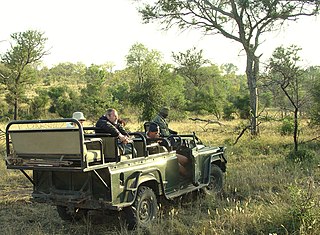 W
WA safari is an overland journey to hunt or observe wild animals, especially in east or southern Africa. Particularly the so-called Big Five game animals of Africa – lion, leopard, rhinoceros, elephant, and Cape buffalo – form an important part of the safari market, both for wildlife viewing and big-game hunting.
 W
WSafety orange is a hue. Safety orange is used to set objects apart from their surroundings, particularly in complementary contrast to the azure color of the sky. The color is commonly used for hunting during the rifle season, and is also used for quail hunting. Most places, such as construction sites, use safety orange to help ensure the safety of others.
 W
WSalburun is a traditional kind of hunt in Kyrghyzstan and Central Asia, involving falconry, archery and sometimes mounted archery, as well as hunting with Taigan.
 W
WScent hounds are a type of hound that primarily hunts by scent rather than sight. These breeds are hunting dogs and are generally regarded as having some of the most sensitive noses among dogs.
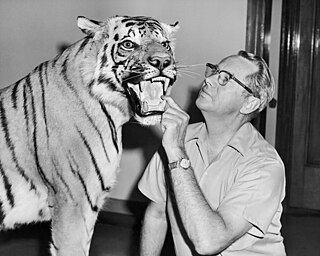 W
WTaxidermy is the art of preserving an animal's body via mounting or stuffing, for the purpose of display or study. Animals are often, but not always, portrayed in a lifelike state. The word taxidermy describes the process of preserving the animal, but the word is also used to describe the end product, which are called taxidermy mounts or referred to simply as "taxidermy".
 W
WTrophy hunting is hunting of wild animals for their trophies, with the trophy being the animal or part of the animal kept and usually displayed, to represent the success of the hunt. The game sought is typically a large or impressively ornamented male, such as one having large horns or antlers. Generally, only parts of the animal are kept as trophies.
 W
WVenatio was a type of entertainment in Roman amphitheaters involving the hunting and killing of wild animals.
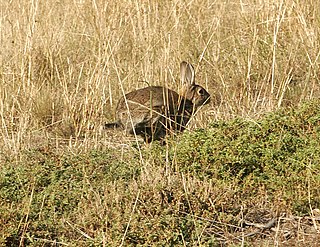 W
WVermin are pests or nuisance animals that spread diseases or destroy crops or livestock. Since the term is defined in relation to human activities, which species are included vary by region and enterprise.
 W
WThe Wild Hunt is a folklore motif that historically occurs in the folklore of various Northern European cultures. Wild Hunts typically involve a "soul-raving" chase led by a mythological figure escorted by a ghostly or supernatural group of hunters passing in wild pursuit. The leader of the hunt is often a named figure associated with Odin in Germanic legends, but may variously be a historical or legendary figure like Theodoric the Great, the Danish king Valdemar Atterdag, the Welsh psychopomp Gwyn ap Nudd, biblical figures such as Herod, Cain, Gabriel, or the Devil, or an unidentified lost soul or spirit either male or female. The hunters are generally the souls of the dead or ghostly dogs, sometimes fairies, Valkyries, or elves.
 W
WA wolf trap was a chase ending in a pit with trapdoor and stakes used by beaters in hunting wolves in medieval Europe.
 W
WCecil was a lion who lived primarily in the Hwange National Park in Matabeleland North, Zimbabwe. He was being studied and tracked by a research team of the University of Oxford as part of a long-term study.